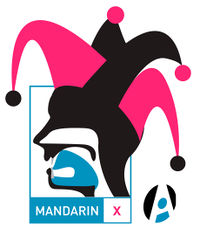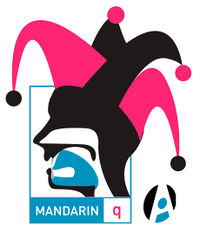The "j" "q" and "x" sounds
-
Level
-
In series Pinyin quick start guide
-
Referenced Initials
You've reached the end of the road! We've saved something special for you, though. The Chinese sounds represented by "x-", "q-", and "j-" in pinyin do not exist in English, and require you to train your mouth to make totally new sounds. Hopefully that sounds like fun! It's not as hard as you might imagine.
Contents
Pronouncing Pinyin's "x" Sound
To learn to make these new sounds, start with the pinyin "x-" sound. You may have heard that it's pronounced like English "sh" or seen it written as the somewhat confusing "hs." Neither of these is particularly helpful; you just have to learn to make a new sound.
To make the pinyin "x-" sound, try to make a "sh" sound while the tip of your tongue is down, below your lower front teeth. The middle of your tongue should rise to the roof of your mouth to make the sound. This should feel weird, because this is not something you normally do in English.
One way you know you're making the "x-" sound correctly is that you can comfortably smile while you make it, whereas it's a bit difficult to do this with the "sh" sound. A good syllable to practice the "x-" sound with first is "xi". Then move on to the super-common word "xièxie" (meaning "thank you").
Let's take a look at all the syllables we can now say:
| Audio | Pinyin | Explanation |
|---|---|---|
| xi | easy; rhymes with yi, mi, etc. | |
| xia | rhymes with ya | |
| xiao | rhymes with yao | |
| xie | rhymes with ye | |
| xiu | there's an "o" dropped here; it's pronounced "xiou" and rhymes with you | |
| xian | rhymes with yan; this "-an" means an "en" sound | |
| xiang | rhymes with yang | |
| xin | rhymes with yin | |
| rhymes with ying | ||
| xiong | rhymes with yong | |
| xu | this is the x- sound with the -ü vowel (remember; that "u" is written without the two dots, just like "yu", but it is actually an "ü" sound!) | |
| xue | xu + "eh" (remember; that "u" is actually a "ü" sound!) | |
| xuan | this is xu + "en", like the "-an" in "yan". You could also pronounce this like xue + -n (remember; that "u" is actually a "ü" sound!) | |
| xun | ryhmes with yun (remember: that "u" is actually a "ü" sound!) |
(Those are all first tone. First tone is most commonly used when introducing syllables in Mandarin Chinese.)
Pronouncing Pinyin's "q" Sound
Once you can make the "x-" sound, move on to the "q-" sound. Again, the pinyin "q-" sound is not the same as the English "ch" sound, although it may sound similar to you at first, and some inaccurate pronunciation guides will tell you they're the same. (If they were really the same, why concoct a "q-" sound at all??)
Pinyin's "x-" and "q-" sounds are very similar to each other, in the same way that "sh" and "ch" sounds are similar to each other (in English as well as in Chinese). You're basically adding a "t" sound to the front of the "x-" to get the "q-" sound. A good syllable to practice the "q-" sound with first is "qi".
For individual syllable with "q-", just apply all the comments under "x" above, replacing all the X's with Q's. All the same logic applies. Let's take a look at just a few of the syllables we can now say:
| Audio | Pinyin | Audio | Pinyin |
|---|---|---|---|
| qi | qie | ||
| qiu | qian |
(Those are all first tone. First tone is most commonly used when introducing syllables in Mandarin Chinese.)
Pronouncing Pinyin's "j" Sound
Finally, move on to "j-", which is not the same as the English "j" sound. The tip of your tongue should be down behind your lower front teeth when making this sound, just as it is for the "x-" and "q-" sounds. If you try to make an English "j" sounds with your tongue in this new position, you should be to make the pinyin "j-" sound. A good syllable to practice the "j-" sound with first is "ji".
For individual syllable with "j-", just apply all the comments under "x" above, replacing all the X's with J's. All the same logic applies. Let's take a look at just a few of the syllables we can now say:
| Audio | Pinyin | Audio | Pinyin |
|---|---|---|---|
| ju | jiang | ||
| jin | jing |
(Those are all first tone. First tone is most commonly used when introducing syllables in Mandarin Chinese.)
Pinyin Chart with Audio
In the chart below, you'll notice that a bunch of the vowels are missing. There is no "a" vowel, no "o" vowel, and no "u" vowel. Those is because pinyin "j-", "q-", and "x-" simply do not combine with those vowels at all. Every time you see a "u" vowel in the chart below, it's actually a "ü" vowel written as "u" for convenience (and a quick check of the column title will make that clear).
Tone: 1 2 3 4 1234 [Show more Settings]
| -i | -i* | -ia | -iao | -ie | -iou | -ian | -iang | -in | -ing | -iong | -ü | -üe | -üan | -ün | ||
|---|---|---|---|---|---|---|---|---|---|---|---|---|---|---|---|---|
| j- | j- | |||||||||||||||
| q- | q- | |||||||||||||||
| x- | x- | |||||||||||||||
| -i | -i* | -ia | -iao | -ie | -iou | -ian | -iang | -in | -ing | -iong | -ü | -üe | -üan | -ün |
After studying these sounds, be sure to take a look at how they fit in with the larger context of the pinyin chart.
Key Takeaways
- The Mandarin Chinese sounds written "x-", "q-", and "j-" do not exist in English; don't let anyone tell you otherwise
- Start with "x-", if you can make that sound, it shouldn't be hard to make "q-" and then "j-"
- When you make the "x-" sound, make sure that the tip of your tongue is down, behind your lower front teeth (and same position for pinyin "q-" and "j-"), and that you can smile as you make it
- Whenever you see the vowel "u" after an "x-", "q-", or "j-", it is actually the "ü" vowel in disguise
Review the "Gotchas"
If you're like most people, there are certain pinyin syllables that are really easy to get wrong. This really is a lot of information to absorb. We've collected all the points that learners are most likely to forget on the pinyin gotchas page. Please refer to this for review!





